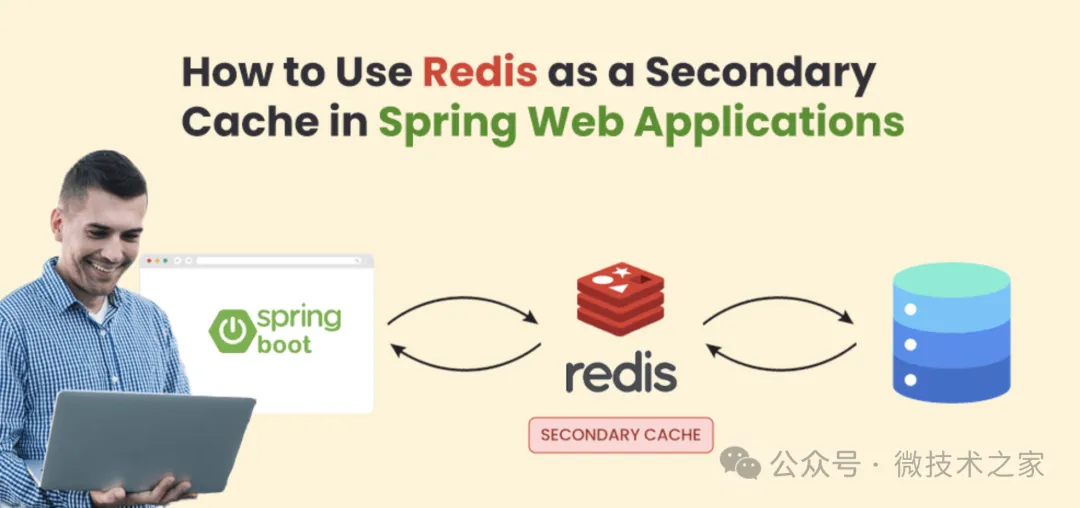使用 Caffeine 和 Redis 实现高效的二级缓存架构
在现代应用开发中,缓存是提升系统性能的关键手段。为了兼顾本地缓存的高性能和分布式缓存的扩展能力,常见的实现方式是结合使用 Caffeine 和 Redis 实现二级缓存架构。

本文将详细介绍如何通过 Spring Boot 实现一个Caffeine + Redis 二级缓存,并通过合理的架构设计和代码实现,确保缓存的一致性、性能和容错性。
一、 需求与挑战
1.多级缓存的需求:
一级缓存(Caffeine):快速响应,存储本地热点数据,减少对远程缓存和数据库的访问。二级缓存(Redis):共享缓存数据,支持分布式扩展。2.常见问题:
数据一致性:一级缓存和二级缓存之间的数据如何保持同步?容错性:Redis 不可用时如何保证系统稳定运行?缓存穿透:如何避免大量无效请求穿透缓存直接访问数据库?高并发:如何避免缓存击穿导致数据库压力激增?二、 缓存设计与解决方案
2.1 缓存查询流程
按照Cache-Aside 模式,缓存查询流程如下:
1.查询一级缓存(Caffeine):如果命中,则直接返回结果。
2.查询二级缓存(Redis):如果 Redis 有数据,则回填到一级缓存,并返回结果。如果 Redis 查询失败(Redis 不可用),直接跳过。3.查询数据源(数据库等):如果 Redis 也未命中,则从数据源获取数据,同时回填到一级和二级缓存中。
2.2 缓存更新流程
数据更新或写入时,同时更新一级和二级缓存。如果 Redis 写入失败,仅更新一级缓存,确保数据可用性。三、代码实现
3.1 缓存接口设计
定义一个通用的缓存接口,便于不同实现类的扩展和切换:
复制
import java.util.Collection;
import java.util.Map;
import java.util.Set;
import java.util.function.Supplier;
public interface CacheService {
<T> T get(String key, Class<T> type, Supplier<T> dataLoader); // 获取单个键的数据
void put(String key, Object value); // 存储单个键的数据
void evict(String key); // 删除单个键
boolean exists(String key); // 检查键是否存在
Map<String, Object> getAll(Set<String> keys); // 批量获取多个键的数据
Object getHash(String key, String hashKey); // 获取哈希表中单个字段的值
void putHash(String key, String hashKey, Object value); // 存储哈希表中的字段
void evictAll(Collection<String> keys); // 批量删除多个键
}1.2.3.4.5.6.7.8.9.10.11.12.13.14.
3.2 Caffeine + Redis 实现
使用 Caffeine 和 Redis 的结合实现二级缓存:
复制
import com.github.benmanes.caffeine.cache.Cache;
import com.github.benmanes.caffeine.cache.Caffeine;
import org.springframework.data.redis.core.RedisTemplate;
import org.springframework.stereotype.Service;
import java.util.concurrent.TimeUnit;
import java.util.function.Supplier;
@Service
public class OptimizedCacheService implements CacheService {
private final Cache<String, Object> caffeineCache;
private final RedisTemplate<String, Object> redisTemplate;
public OptimizedCacheService(RedisTemplate<String, Object> redisTemplate) {
this.caffeineCache = Caffeine.newBuilder()
.initialCapacity(100)
.maximumSize(1000)
.expireAfterWrite(10, TimeUnit.MINUTES)
.build();
this.redisTemplate = redisTemplate;
}
@Override
public <T> T get(String key, Class<T> type, Supplier<T> dataLoader) {
// Step 1: 查询一级缓存(Caffeine)
T value = (T) caffeineCache.getIfPresent(key);
if (value != null) {
return value;
}
// Step 2: 查询二级缓存(Redis)
try {
value = (T) redisTemplate.opsForValue().get(key);
if (value != null) {
// 回填到一级缓存
caffeineCache.put(key, value);
return value;
}
} catch (Exception e) {
// Redis 不可用时记录日志
System.err.println("Redis 不可用:" + e.getMessage());
}
// Step 3: 查询数据源(数据库等)
value = dataLoader.get();
if (value != null) {
// 回填到缓存
caffeineCache.put(key, value);
try {
redisTemplate.opsForValue().set(key, value, 10, TimeUnit.MINUTES);
} catch (Exception e) {
System.err.println("Redis 存储失败:" + e.getMessage());
}
}
return value;
}
@Override
public void put(String key, Object value) {
// 同时更新一级缓存和二级缓存
caffeineCache.put(key, value);
try {
redisTemplate.opsForValue().set(key, value, 10, TimeUnit.MINUTES);
} catch (Exception e) {
System.err.println("Redis 存储失败:" + e.getMessage());
}
}
@Override
public void evict(String key) {
// 同时移除一级缓存和二级缓存
caffeineCache.invalidate(key);
try {
redisTemplate.delete(key);
} catch (Exception e) {
System.err.println("Redis 删除失败:" + e.getMessage());
}
}
@Override
public boolean exists(String key) {
// 检查一级缓存
if (caffeineCache.asMap().containsKey(key)) {
return true;
}
// 检查二级缓存
try {
return Boolean.TRUE.equals(redisTemplate.hasKey(key));
} catch (Exception e) {
System.err.println("Redis 检查键失败:" + e.getMessage());
return false;
}
}
@Override
public Map<String, Object> getAll(Set<String> keys) {
// 优先从一级缓存中获取
Map<String, Object> result = caffeineCache.getAllPresent(keys);
// 还需要获取的键
Set<String> missingKeys = keys.stream()
.filter(key -> !result.containsKey(key))
.collect(Collectors.toSet());
if (!missingKeys.isEmpty()) {
try {
// 从 Redis 获取剩余的键
List<Object> redisResults = redisTemplate.opsForValue().multiGet(missingKeys);
if (redisResults != null) {
for (int i = 0; i < missingKeys.size(); i++) {
String key = missingKeys.toArray(new String[0])[i];
Object value = redisResults.get(i);
if (value != null) {
result.put(key, value);
caffeineCache.put(key, value); // 回填一级缓存
}
}
}
} catch (Exception e) {
System.err.println("Redis 批量获取失败:" + e.getMessage());
}
}
return result;
}
@Override
public Object getHash(String key, String hashKey) {
try {
return redisTemplate.opsForHash().get(key, hashKey);
} catch (Exception e) {
System.err.println("Redis 获取哈希字段失败:" + e.getMessage());
return null;
}
}
@Override
public void putHash(String key, String hashKey, Object value) {
try {
redisTemplate.opsForHash().put(key, hashKey, value);
} catch (Exception e) {
System.err.println("Redis 存储哈希字段失败:" + e.getMessage());
}
}
@Override
public void evictAll(Collection<String> keys) {
// 删除一级缓存
caffeineCache.invalidateAll(keys);
// 删除二级缓存
try {
redisTemplate.delete(keys);
} catch (Exception e) {
System.err.println("Redis 批量删除失败:" + e.getMessage());
}
}
}1.2.3.4.5.6.7.8.9.10.11.12.13.14.15.16.17.18.19.20.21.22.23.24.25.26.27.28.29.30.31.32.33.34.35.36.37.38.39.40.41.42.43.44.45.46.47.48.49.50.51.52.53.54.55.56.57.58.59.60.61.62.63.64.65.66.67.68.69.70.71.72.73.74.75.76.77.78.79.80.81.82.83.84.85.86.87.88.89.90.91.92.93.94.95.96.97.98.99.100.101.102.103.104.105.106.107.108.109.110.111.112.113.114.115.116.117.118.119.120.121.122.123.124.125.126.127.128.129.130.131.132.133.134.135.136.137.138.139.140.141.142.143.144.145.146.147.
3.3 空值缓存(防止缓存穿透)
为了避免查询不存在的数据穿透到数据库,可以将空值存储到缓存中:
复制
if (value == null) {
// 存储空值到缓存,防止穿透
caffeineCache.put(key, "NULL");
try {
redisTemplate.opsForValue().set(key, "NULL", 1, TimeUnit.MINUTES);
} catch (Exception e) {
System.err.println("Redis 存储空值失败:" + e.getMessage());
}
return null;
}
if ("NULL".equals(value)) {
return null;
}1.2.3.4.5.6.7.8.9.10.11.12.13.
3.4 异步更新 Redis(提升写性能)
为了提高写操作性能,可以将 Redis 的更新操作放到异步线程中:
复制
private void asyncUpdateRedis(String key, Object value) {
new Thread(() -> {
try {
redisTemplate.opsForValue().set(key, value, 10, TimeUnit.MINUTES);
} catch (Exception e) {
System.err.println("Redis 异步更新失败:" + e.getMessage());
}
}).start();
}1.2.3.4.5.6.7.8.9.
在put和get方法中调用asyncUpdateRedis。
3.5 定时清理 Caffeine
Caffeine 默认是惰性清理(Lazy Cleanup)。如果需要主动清理,可以通过定时任务触发:
复制
@Scheduled(fixedRate = 60000) // 每分钟执行一次
public void cleanUpCache() {
caffeineCache.cleanUp();
}1.2.3.4.

四、总结与优势
4.1 架构特点
性能更高:直接按一级缓存 -> 二级缓存 -> 数据库的顺序查询,减少了 Redis 可用性检查的开销。降级容错:当 Redis 不可用时,不影响数据加载和缓存更新。缓存一致性:通过回填机制,尽量保持一级缓存和二级缓存的数据一致性。可扩展性:支持空值缓存、异步更新、主动清理等增强功能。4.2 应用场景
高频访问的数据(如热门商品、热点新闻)。分布式应用需要共享缓存的数据。对性能和容错性有较高要求的业务场景。通过 Caffeine 和 Redis 的结合,可以构建一个高效、灵活、稳定的二级缓存架构,有效提升系统性能并降低后端服务压力。
THE END